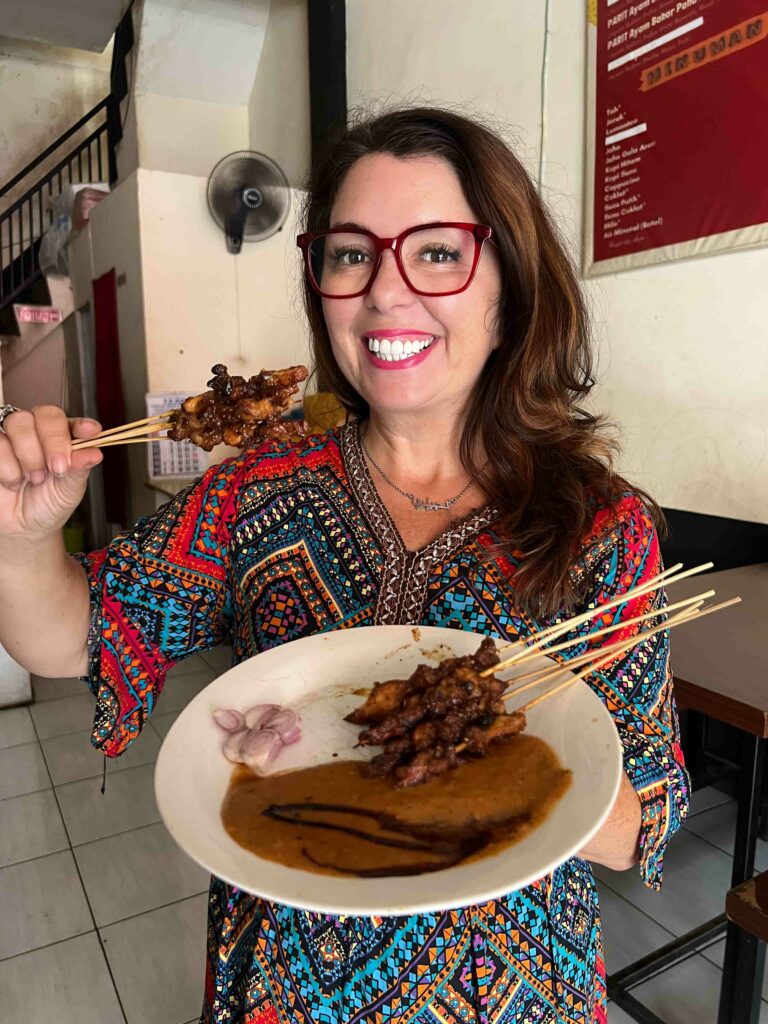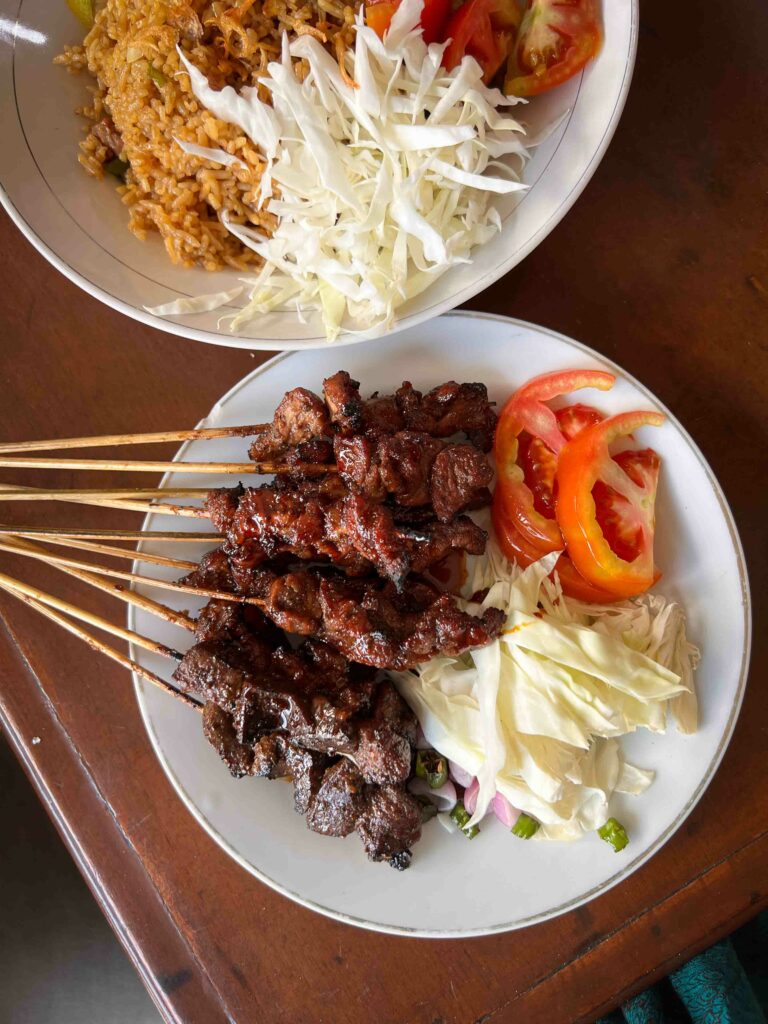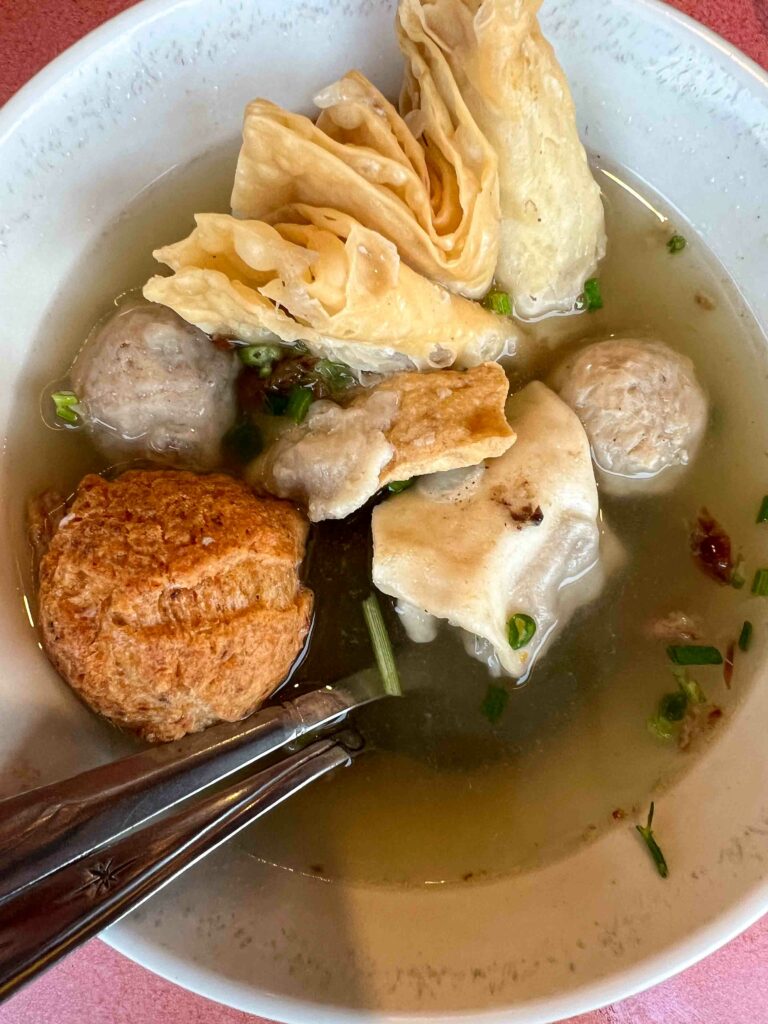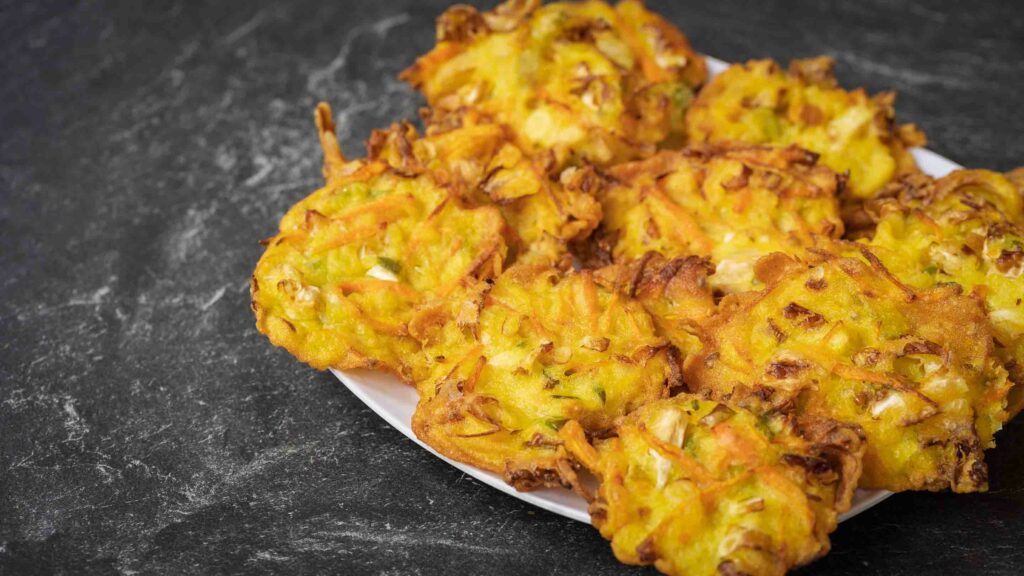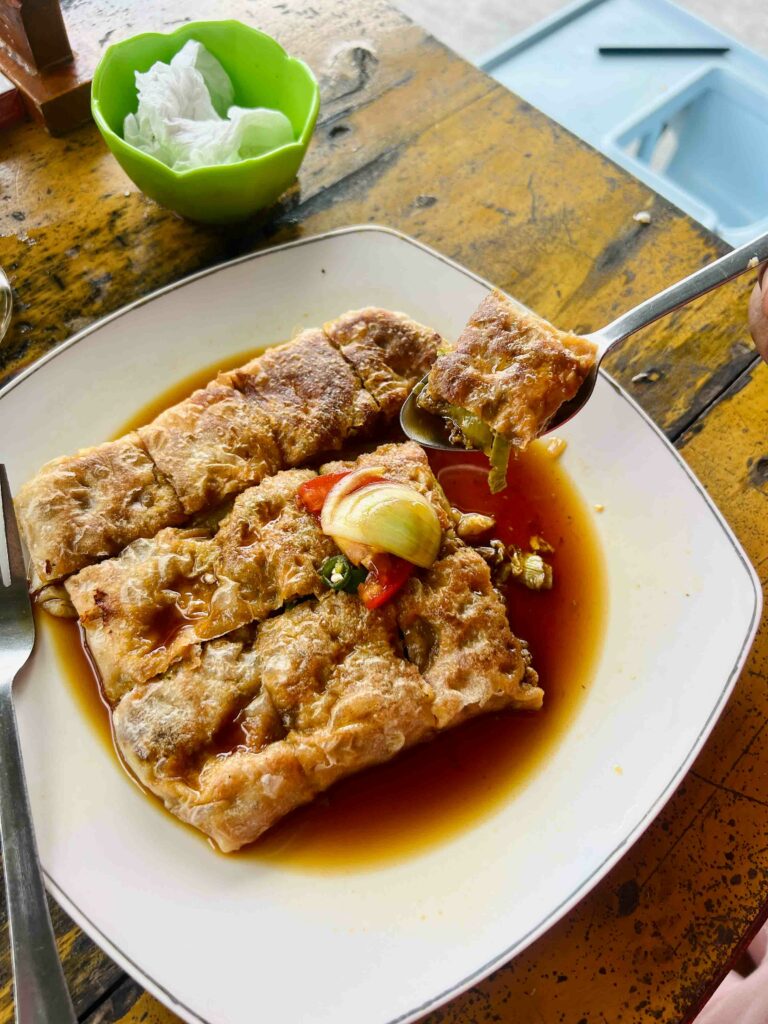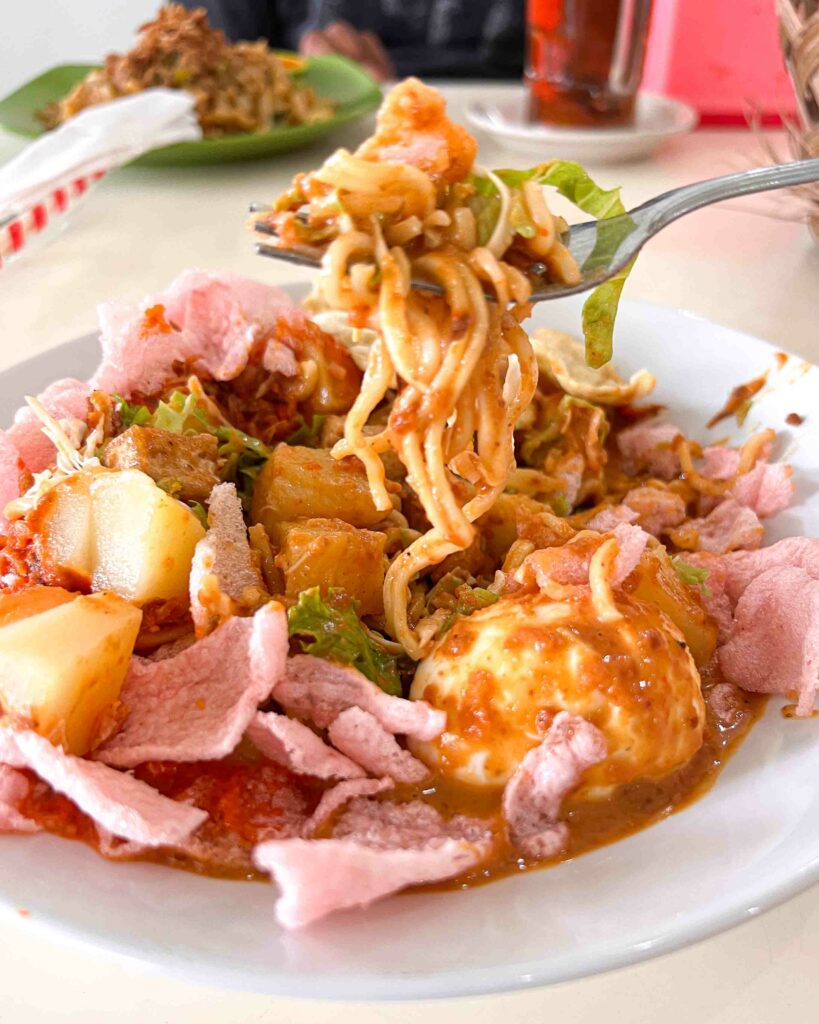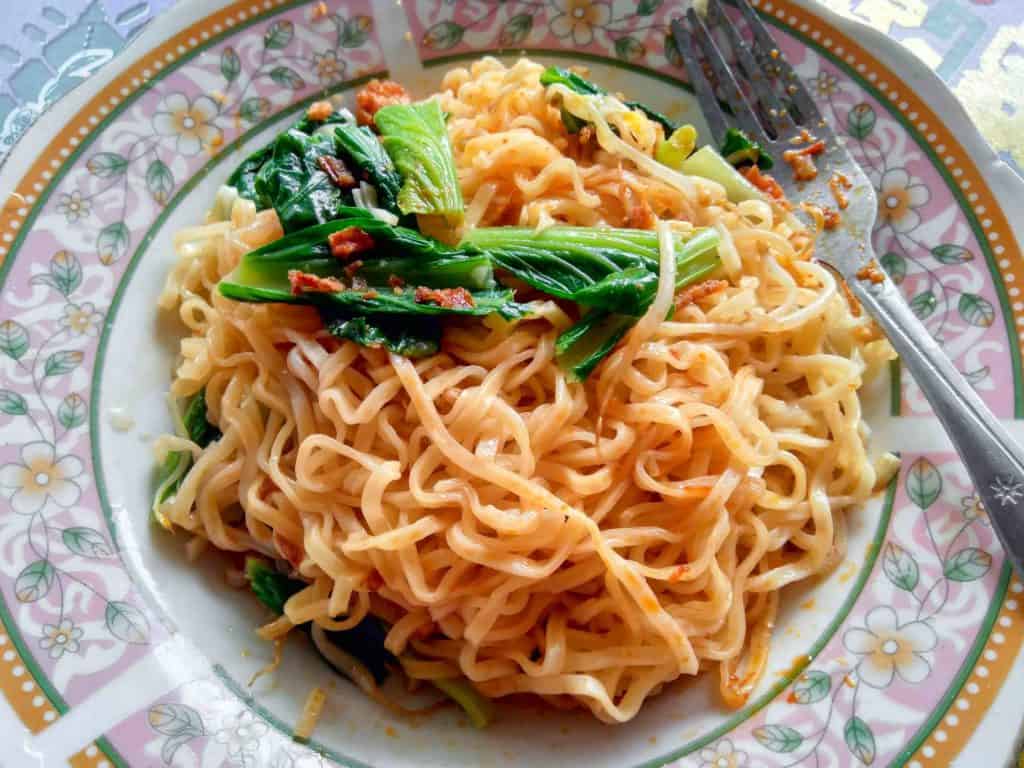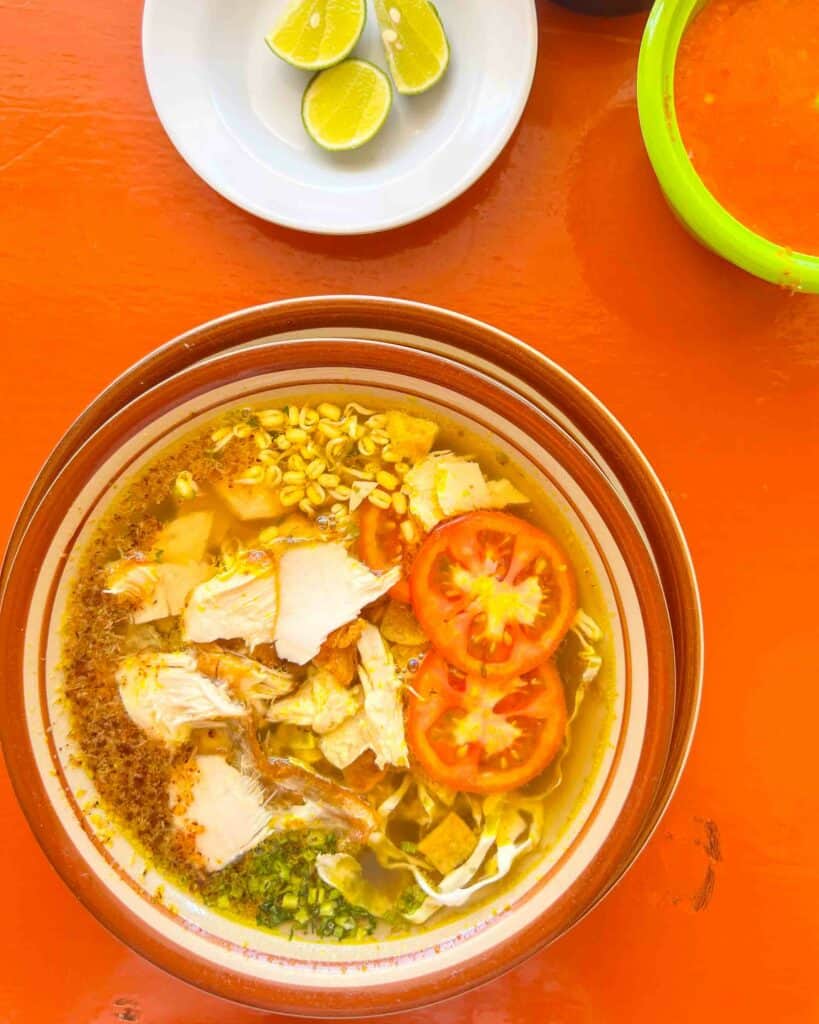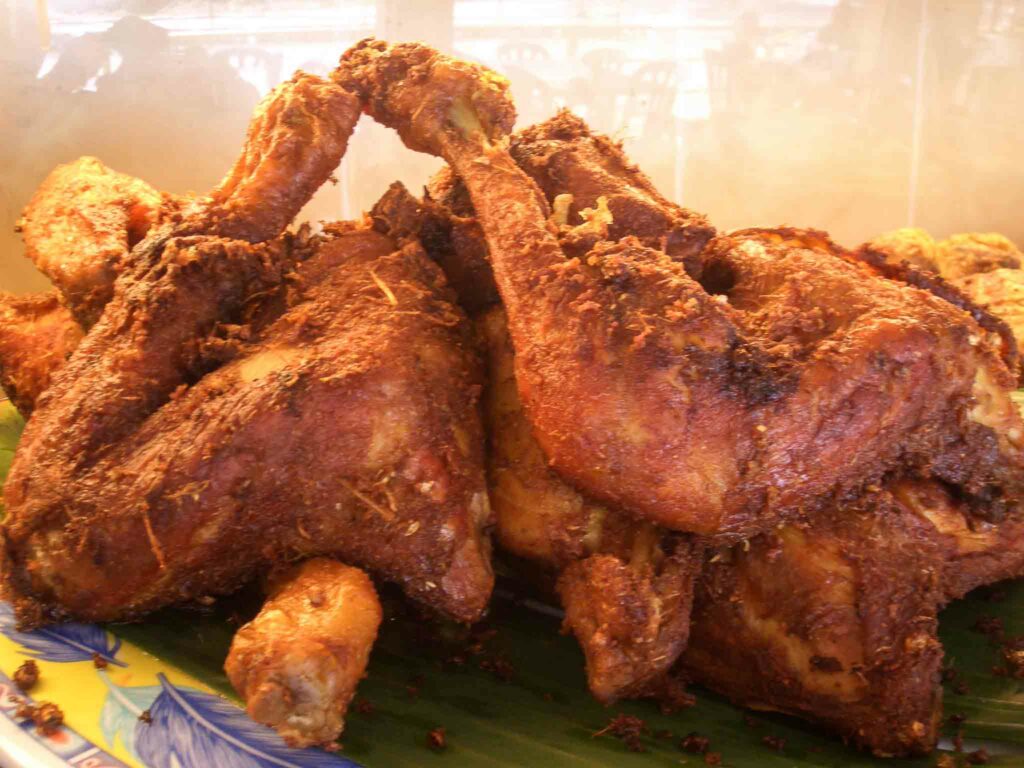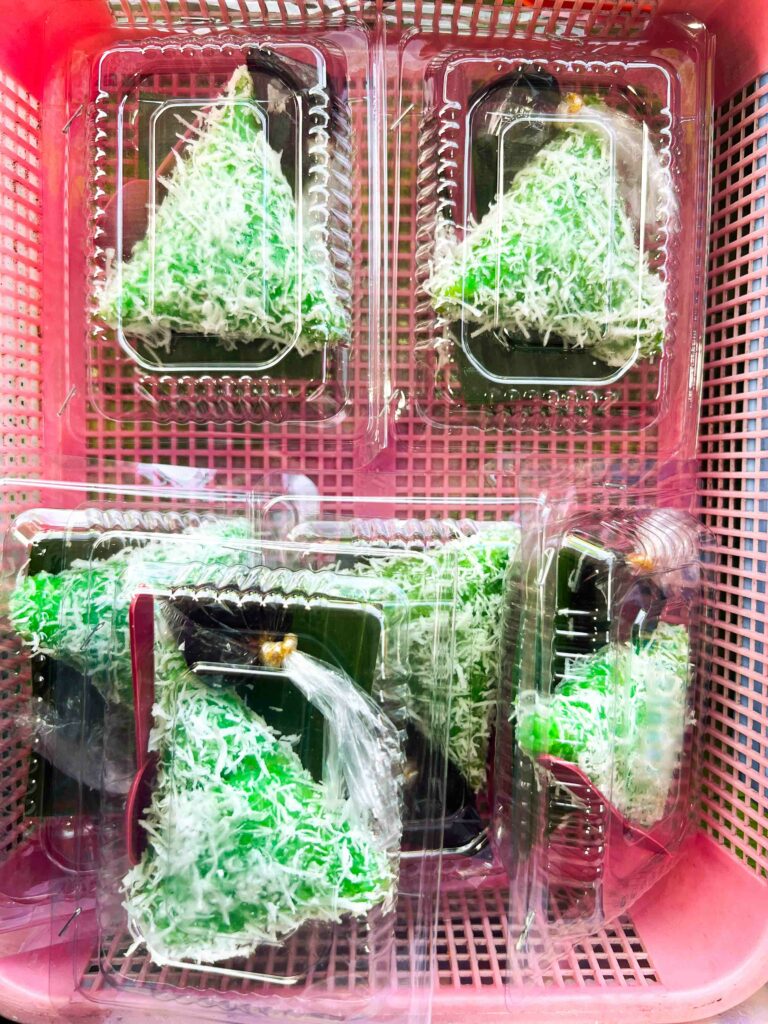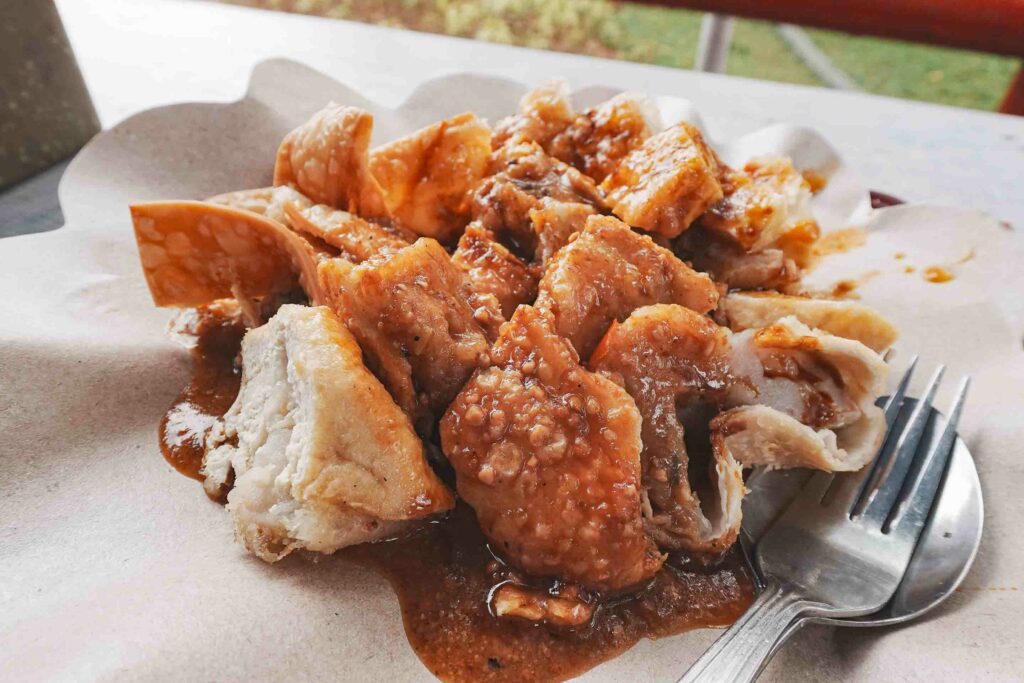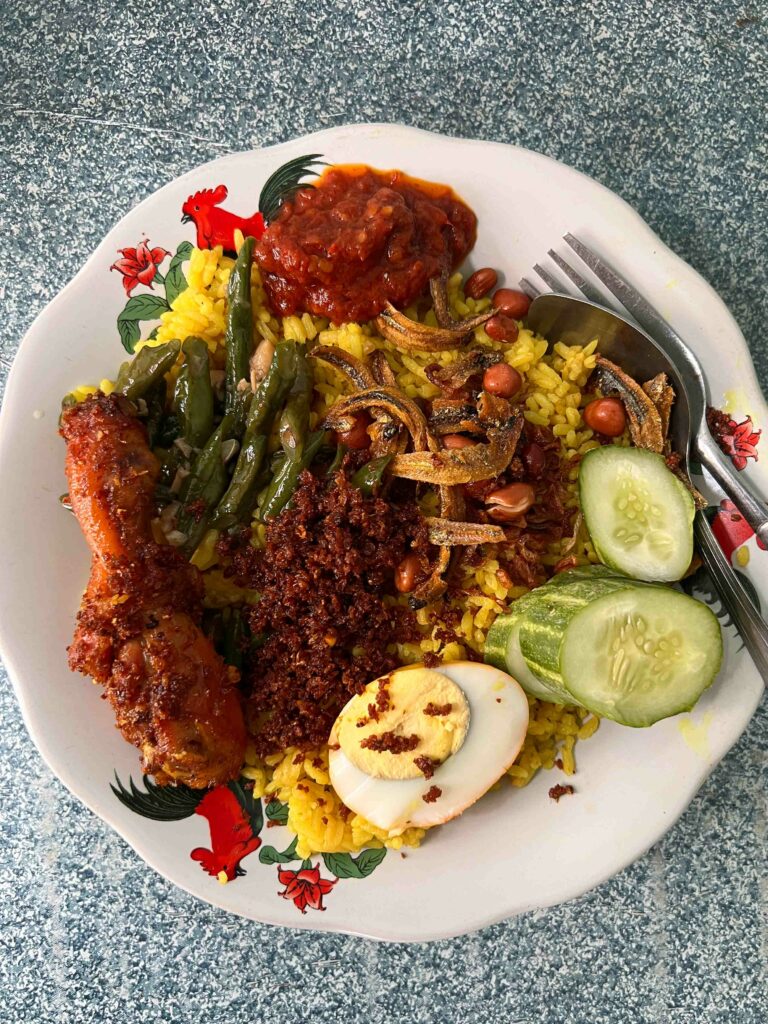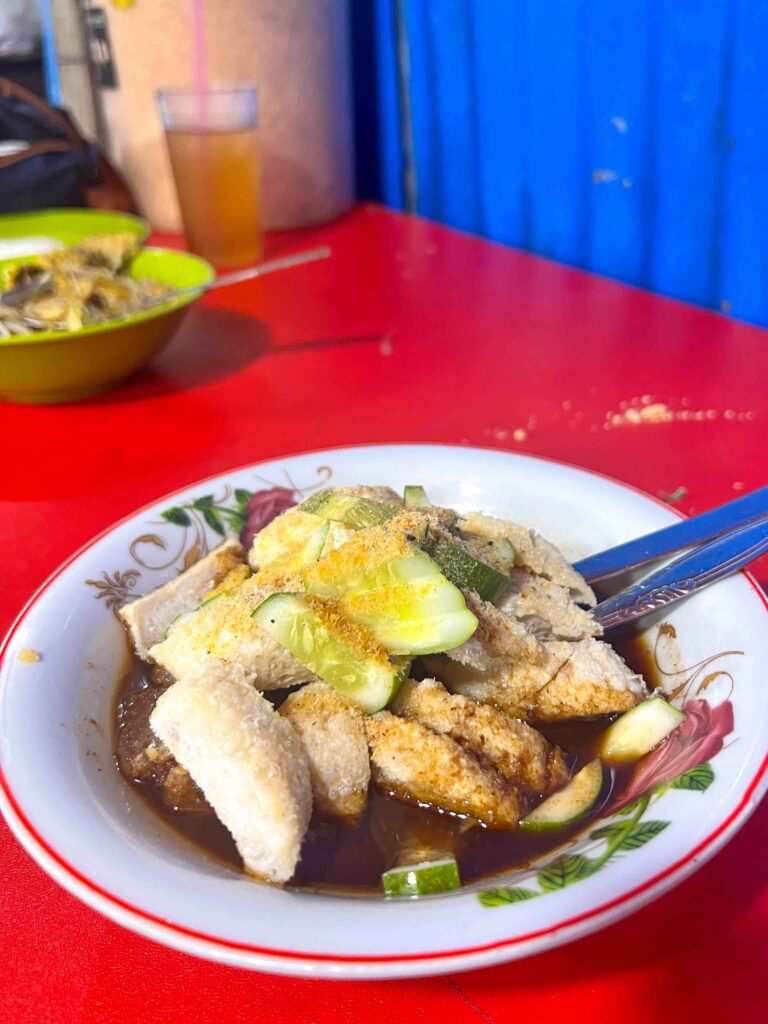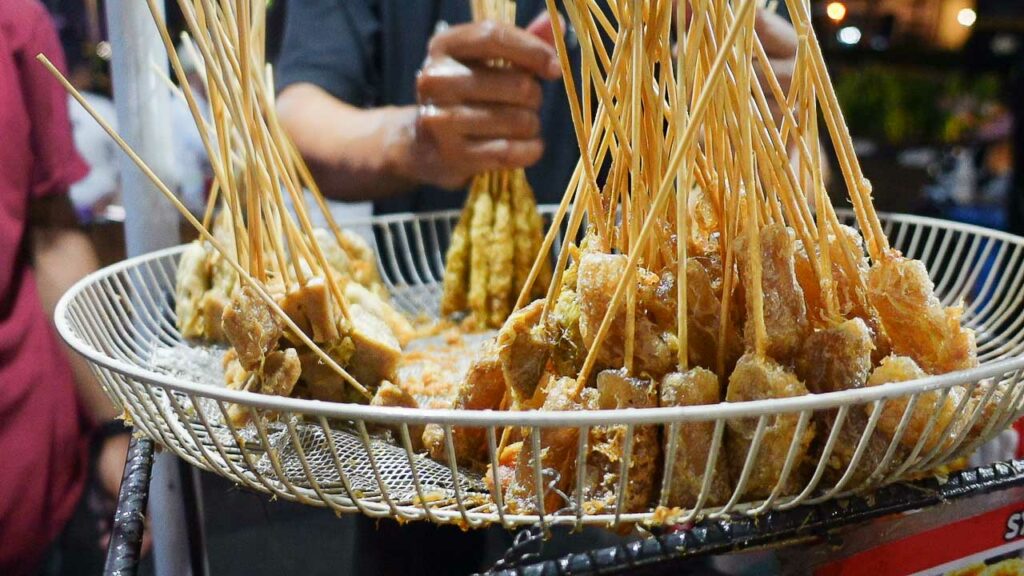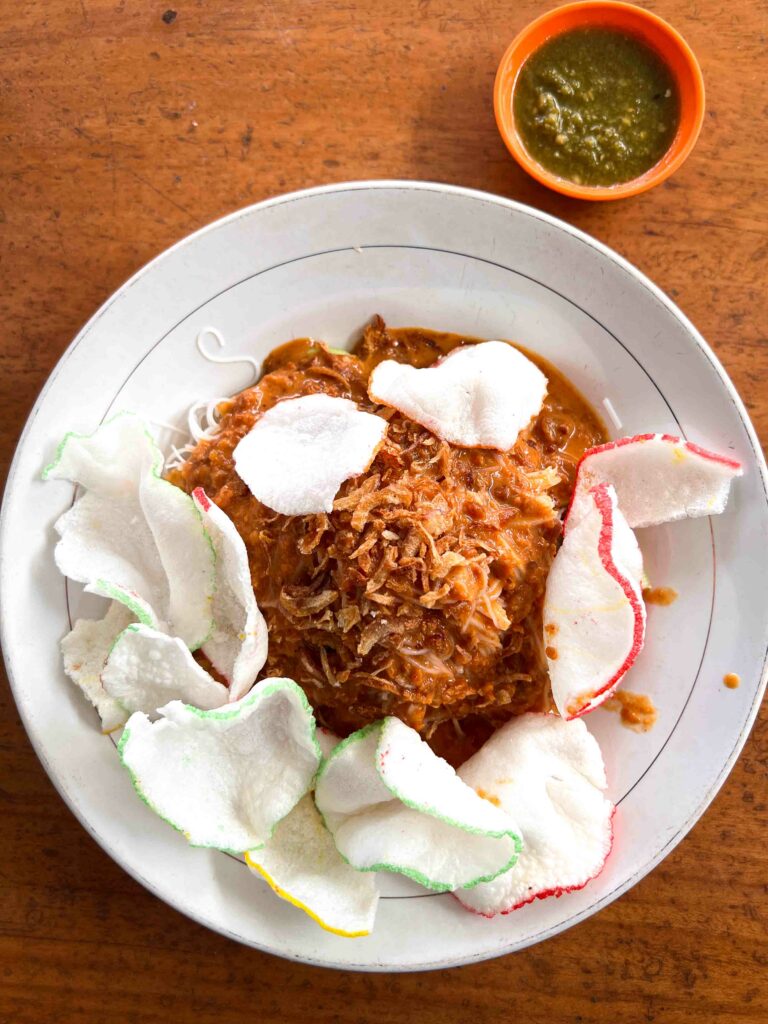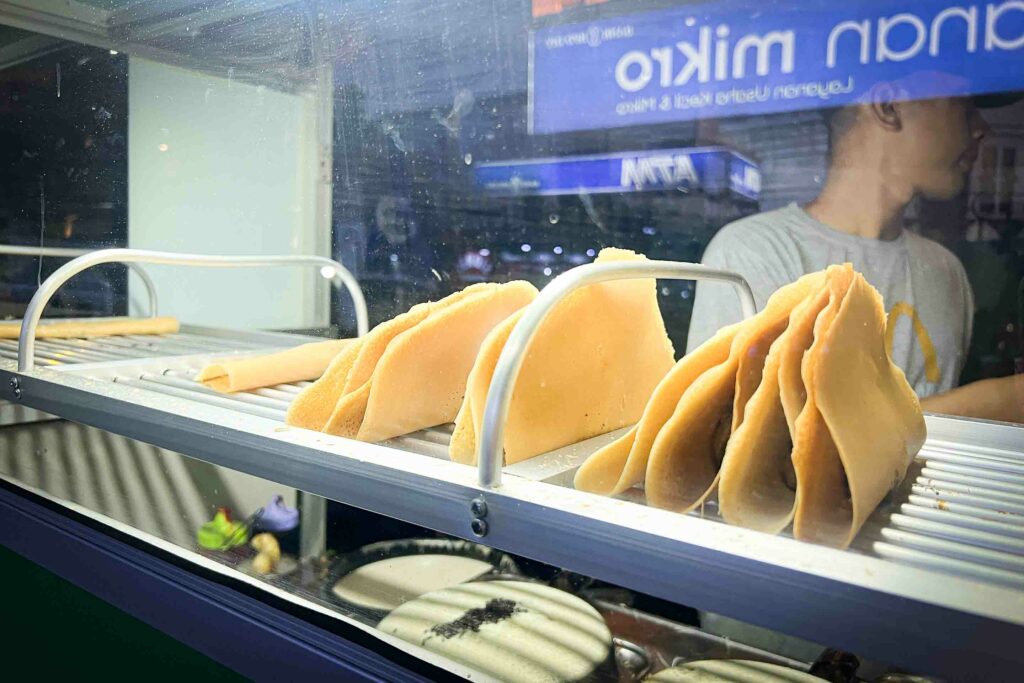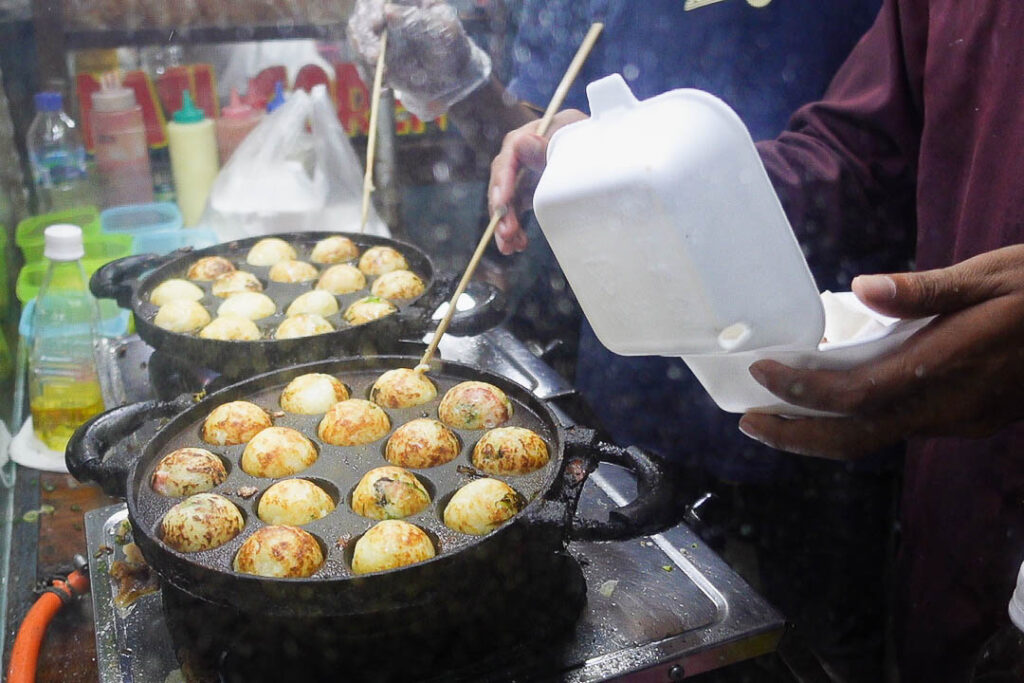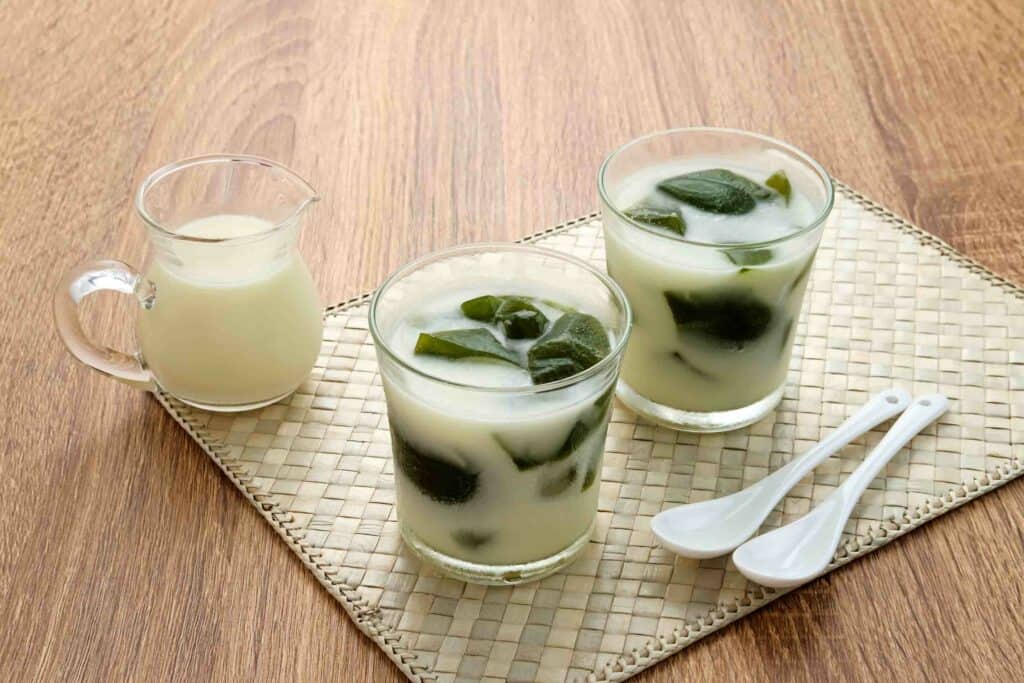Indonesian street food is a way of life. It’s not just for those who can’t afford to eat in restaurants but for people who want to eat the best food in Indonesia.
In Indonesia, street food is a huge part of the way of life in the country. There is such a diverse offering of dishes, whether at street food vendors, warungs, and food carts.
And even fine dining restaurants have adapted because Indonesians crave the taste that locals crave.
Indonesian Food
At the best street food spots you’ll see a line of SUVs popping in for take out. And food delivery service drivers are popping in to pick up orders.
Indonesian street food is unique to each island, although there are several dishes you’ll find everywhere with local variations.
Indonesian Street Food Influences
Street food in Indonesia has been influenced by various countries and immigrants over the years. Some of the significant influences include:
- Chinese influence: Chinese immigrants have had a significant impact on Indonesian street food. Chinese dishes such as bakmi (noodles), bakso (meatballs), and siomay (steamed dumplings) have become popular street food in Indonesia.
- Indian influence: Indian spices and cooking techniques have also influenced Indonesian street food. Dishes such as nasi kebuli (spiced rice), roti canai (Indian-style flatbread), and samosas are popular street foods in Indonesia.
- Dutch influence: The Dutch colonial period in Indonesia has also left its mark on Indonesian street food. Dishes such as bitterballen (deep-fried meatballs), kroket (croquettes), and frikandel (deep-fried sausage) are popular street foods in Indonesia.
- Malay influence: The Malay influence on Indonesian street food is evident in dishes such as nasi lemak (coconut rice) and satay.
- Middle Eastern influence: Middle Eastern influence on Indonesian street food is visible in dishes such as grilled meat and prevalence of goat and lamb.
Social media has opened up the world to a variety of food. At night markets you’ll also see a lot of food from Japan and South Korea.
Street Food in Indonesia You’ll Love
1. Sate / Satay
Sate is a traditional Indonesian street food item that consists of meat that is marinated, seasoned, threaded onto a skewer.
The skewered meat, whether chicken, pork, or beef, is either grilled or barbecued. It may be served with sauce. It is also often accompanied by lontong as a side dish.
Sate is one of five national dishes of Indonesia. Yes, that’s right. Indonesia is so diverse it needs five national foods.
The sate is believed to have originated from the island of Java,. But is found throughout the country today, on almost every street corner, warung and restaurant.
There are many different variations of this street food in Indonesia, depending on where you are in the country.
Fruits in Indonesia
2. Tahu Bulat / Round Tofu
Tahu bulat is a famous Indonesian street food snack. These round balls of tofu that are seasoned and deep fried until golden brown.
It is often made in the back of a pick-up truck that drives around to sell the crispy fried tofu balls.
They will hang around at a location for anywhere between 5 and 20 minutes, selling the tahu bulat in masses before moving on to their next location.
3. Bakso / Meatball
One of the most famous Indonesian street food dishes is bakso.
The dish consists of meatballs served in soup.Depending on where you are there could be noodles and vegetables, and sometimes boiled eggs too.
It is the staple food for many Indonesians. It can be found almost everywhere in the country, from dedicated bakso carts all the way up to fancy restaurants.
I’ve had it many times different ways. But I didn’t really love it until researching Malang food as it is the home of bakso.
Here they serve it in just a broth with two different kinds of bakso, siomay, a black eye pea fritter and two kinds of wonton dumplings.
In Jakarta it is a baseball size ball of meat. Sometimes with a boiled egg in the middle, and served with broth. Too much meat for me!
4. Gorengan / Fried Food
Gorengan is one of the most famous Indonesian street food snacks.
Essentially it means fried food. So it can include anything, such as the bakwan or fried fritters in the photo above.
There are many different varieties of gorengan, both sweet and savory. You’ll find them most often at local street food carts after work.
5. Martabak
Martabak are thick Indonesian street food pancakes that can either be sweet or savory. The sweet version, martabak manis, is usually made up of a chocolate and nut filling.
The savory version, called martabak telur, is usually filled with an egg and meat mixture and served with a vinegar sauce called saus cuka.
You will, however, always find martabak being sold from the cart of a street vendor.
6. Gado-Gado / Mix-Mix
Gado-gado is an Indonesian salad of mixed vegetables that is served with a peanut sauce, found throughout the country.
The dish can be made up of any mix of vegetables – the options are endless.
However, common ingredients include spinach, beansprouts, potato, cucumber, carrot, tempeh, and tofu.
The real hero of this Indonesian street food dish is the peanut sauce.
This is no ordinary peanut sauce. It’s made using fried peanuts, chili, garlic, tamarind, kecap manis, shrimp paste, palm sugar, and lime juice.
The sauce is both sweet and savory. It is really harmoniously brings the ingredients together and takes the dish to the next level.
Indonesia Vegetarian Food
7. Kerak Telor / Egg Crust
Kerak telor is an Indonesian street food snack that was created by the Betawi people in Jakarta.
The dish is made up of glutinous rice cooked with egg as a form of spicy omelet that is topped with shredded coconut, fried shallots, and dried shrimp.
Kerak telor can be found being sold by street vendors in Jakarta and is also the street food in Indonesia that is popular during the Jakarta Fair.
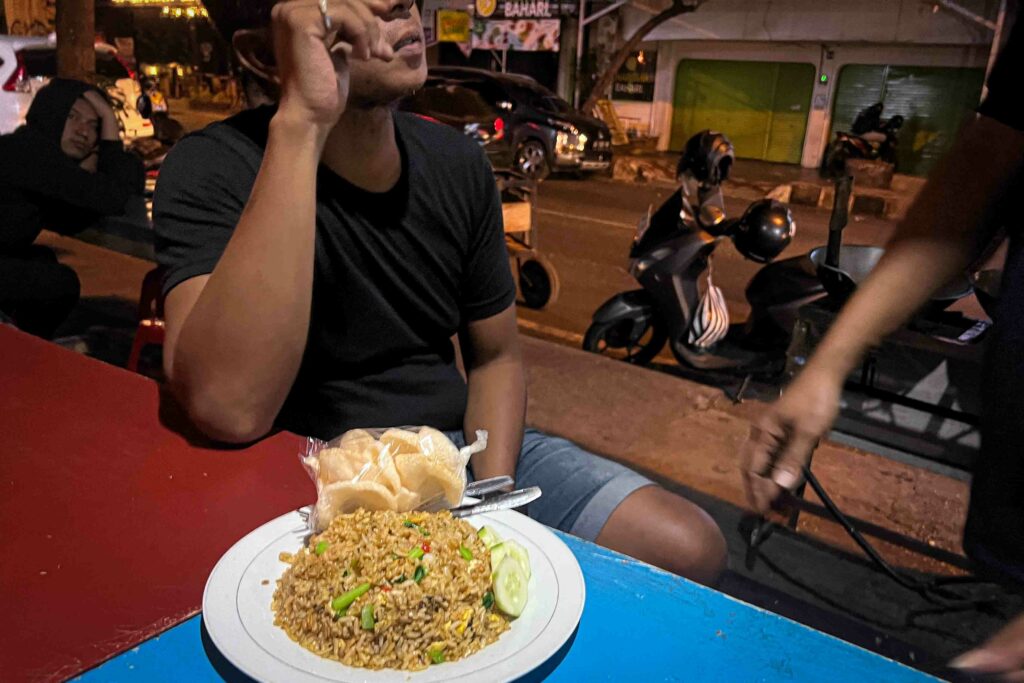
8. Nasi Goreng / Fried Rice
One of the five national dishes in Indonesia it may be the most popular street food in Indonesia.
People swear it tastes better on the street and the best places have a line of locals.
The recipe often stays quite simple in terms of rice, some vegetables, maybe a meat or egg and then cucumber and crackers on the side.
So the real test of a nasi goreng vendor is keeping it crispy, not oily, and using the best spices.
Surabaya Food
9. Nasi Gila / Crazy Rice
Nasi gila is known as Indonesian crazy rice, made by frying rice together with vegetables and meat.
It contains a base paste made from chili, garlic, cayenne, shrimp paste, shallots, candlenut\ and ginger. It is usually served with crispy prawn crackers called krupuk.
Sausages are sliced up and fried together in the mix along with meatballs, vegetables, and green mustard.
Nasi gila is a traditional Javanese dish that is rarely found outside of the island and can be found being sold at markets, street food vendors, and warungs.
It is the perfectly spicy and mouth-watering dish that will have you coming back for more time after time.
The additional mix of sausage and vegetables is what turns this variation of nasi goreng into the only known Indonesian street food dish that is worthy of the term “crazy”.
10. Mie Goreng / Fried Noodles
Alongside nasi goreng you’ll find vendors also serving mie goreng which is fried noodles.
The ingredients are usually the same and simply tossed with noodles but the kind of noodle matters.
Some people prefer the Indomie instant packet noodles but I think the best are when they use the yellow noodles.
And if they make those yellow noodles you know it’s going to be good.
If you can’t decide between fried noodles or rice ask for minas, which is a mix of both.
Teh Talua Recipe
11. Mie Aceh / Aceh Noodles
Mie Aceh originates from the most western province of Indonesia in Northern Sumatra called Aceh.
Thick yellow noodles, that are normally homemade, are served in a hot and spicy soup.
Slices of meat spiced with a mix called bumbu is added to the soup along with vegetables and served hot.
Mie Aceh has two variations – a dry version called mie Aceh goreng, that is fried and served without soup and a mie Ache kuah which is the soup-based version.
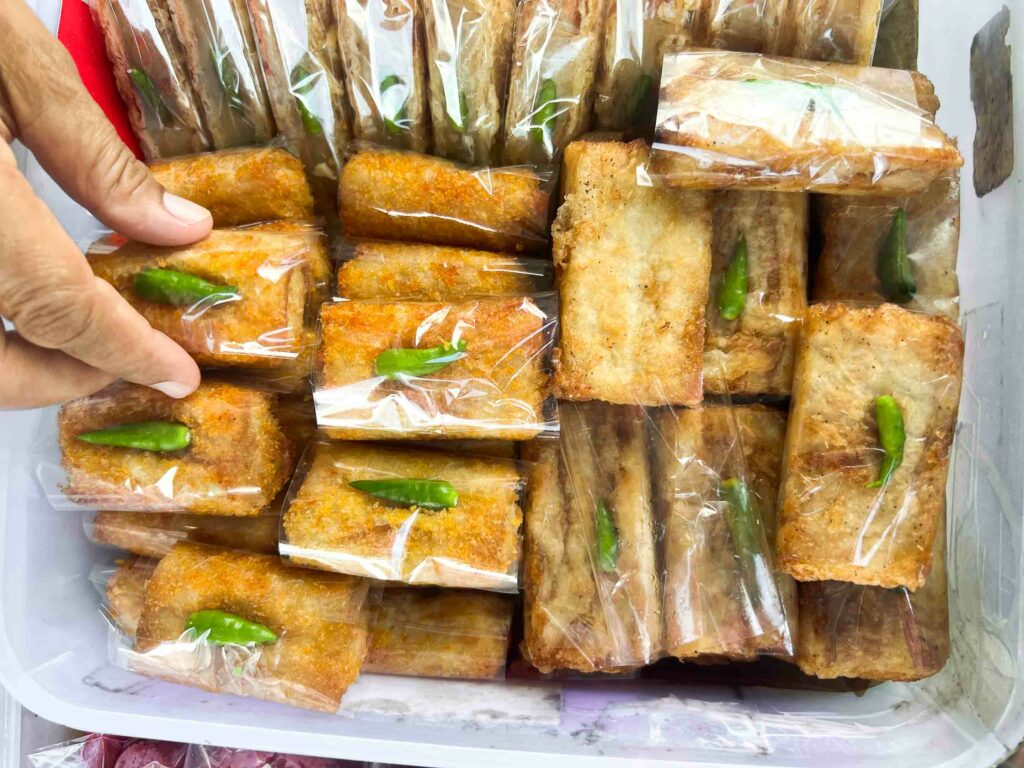
12. Risoles
Risoles is a popular snack in Indonesia that originated from the Dutch croquette.
It is a deep-fried pastry filled with a mixture of vegetables, meat, and sometimes cheese, wrapped in a thin crepe-like wrapper.
It is often served as a snack or appetizer and can be found in many street food stalls and restaurants throughout Indonesia.
Be careful with the chili as it’s spicy!
13. Cilok
Cilok is a form of Indonesian dumpling that is made using tapioca flour that is served with a delicious peanut dipping sauce.
The Indonesian street food snack originated from the city of Bandung in West Java.
Tapioca flour is mixed with dried shrimp, scallions, and garlic and is seasoned with salt, sugar, and white pepper.
Once the dough is formed, it’s either cooked in hot water or oil to finish off the glossy, opaque balls.
While the fried version is available, it is the boiled version that is most widely available at street food vendor’s stands throughout the country.
14. Soto Ayam / Chicken Soup
You will find chicken soup everywhere in Indonesia.
Soto ayam is a national dish of Indonesia and for a good reason. There are so many variations and many cities, like Lamongan in East Java, are famous for them.
Even in hot weather you’ll find chicken soup here light, comforting and full of flavor.
15. Soto Tangkar
Soto tangkar is a traditional Betawi / Jakartan soup made using beef ribs as the main ingredient.
There is a long history of the dish, dating back to the colonial days when beef ribs were considered a secondary cut and thus given to the locals.
Soto tangkar was then developed using beef ribs, together with coconut milk, and a combination of spices.
It is quite a rare modern day Indonesian street food dish. But some street vendors and restaurants still make this colonial-era dish.
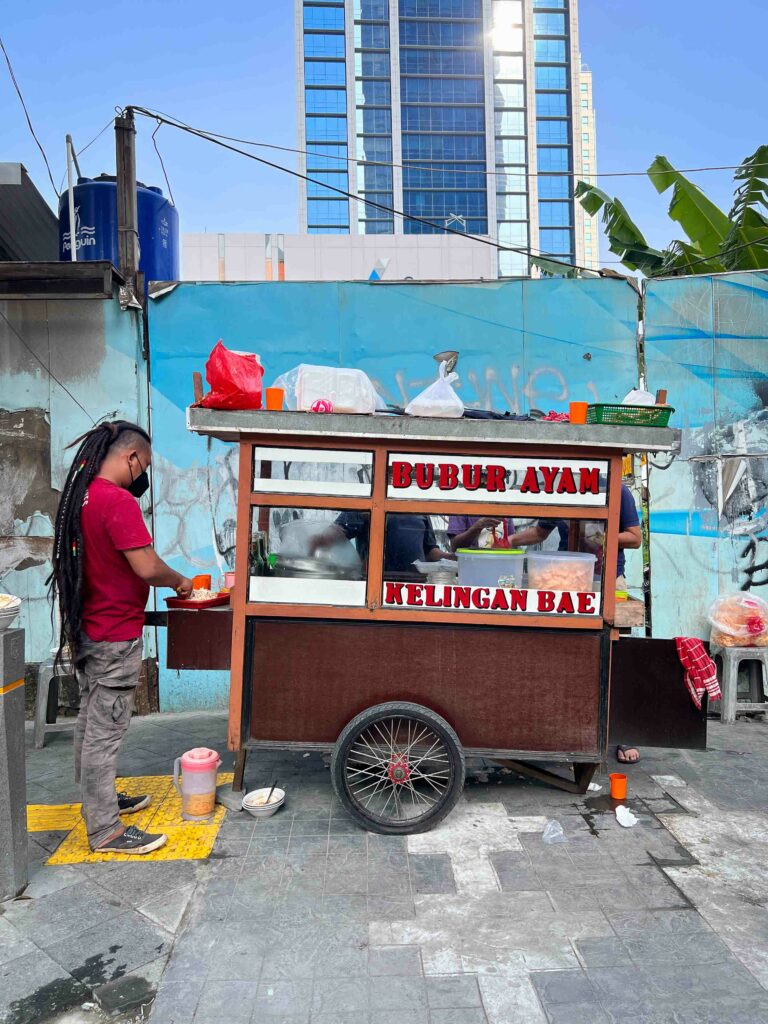
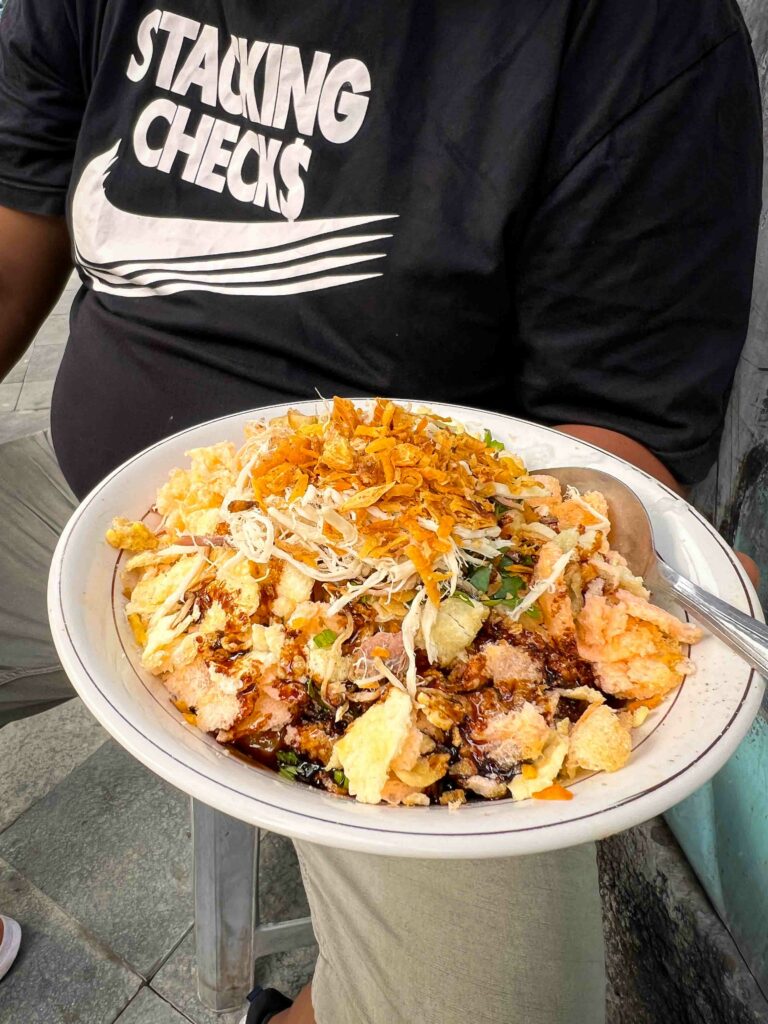
16. Bubur Ayam / Chicken Congee
Bubur ayam is essentially a chicken congee dish, although different to a traditional congee dish.
This common Indonesian street food dish is found throughout the country and is usually sold by street food vendors, warungs, and even high-end establishments.
But my absolute favourite is sold on the street. And it’s so good you’ll see men in suits and women in very expensive clothing sitting on plastic stools next to laborers.
It is a well-known breakfast item consisting of shredded chicken and rice served with a selection of condiments.
You make it as spicy as you want.
And like many dishes it has regional differences. One of the most popular is Bandung bubur ayam which uses shredded chicken.
17. Nasi Manado / Manado Rice
Not only is Manado a city in north-western Indonesia on the Island of Sulawesi, but it is also a way of cooking that originated from its namesake.
This traditional Indonesian street food dish consists of rice that is surrounded by a pork skewer as well as other spicy foods.
18. Ayam Goreng / Fried Chicken
Ayam goreng is a simple Javanese street food dish of fried chicken.
It doesn’t have the typical heavy KFC batter but it does have a crispy skin.
If you’re lucky they will use countryside chicken or kampung as it has a strong and better flavor.
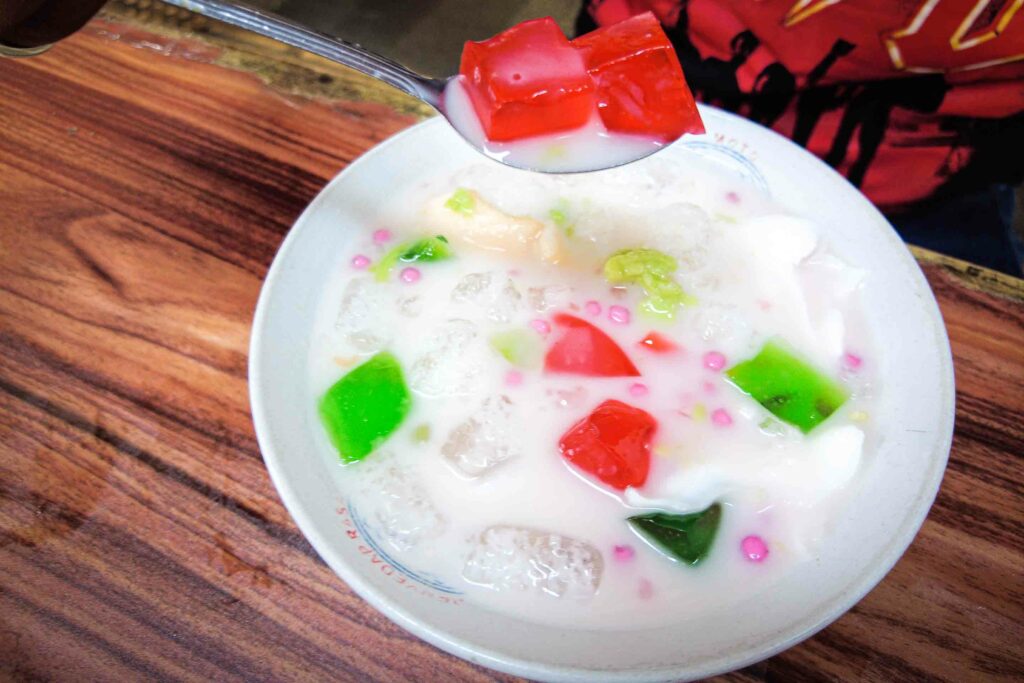
19. Cendol
Many Asian countries have a sweet street food that I’m not sure if it is a drink, cold soup, or dessert.
But generally it’s a liquid, often on ice with a number of colorful jelly noodles made from rice flour and other ingredients.
In Indonesia I think cendol is the most common. It uses coconut milk, jellies and is sweetened with pam sugar.
It ranges from sickeningly sweet to just a touch of sweetness that is cool and refreshing.
Drinks in Indonesia
20. Pisang Cokelat / Banana Chocolate
Pisang cokelat is one of the sweet Indonesian street food snacks tof fried bananas drizzled in chocolate and then wrapped in a thin, crepe-like pastry.
They are often referred to as choco banana spring rolls and combine two of the favorite dessert items in one.
Pisang cokelat is the perfect afternoon sweet treat but can also be enjoyed after dinner at a restaurant or from a street food vendor.
21. Kue Lupis
Kue means cake in Indonesian and there are so many sweet treats called kue.
This is a traditional Indonesian sweet snack made from glutinous rice flour, coconut milk, and pandan leaves.
The mixture is shaped into small balls, flattened, and boiled until cooked. It is served with grated coconut and palm sugar syrup.
It is a popular snack during special occasions, such as weddings and festivals. I found these ones during Ramadan along with so many other sweet snacks.
22. Kue Serabi
Kue serabi is a form of Indonesian pancake that is made by combining rice flour with shredded coconut and coconut milk.
These Indonesian street food snacks can be found throughout the country at local markets or at street food vendors, although they originated from Java.
The iconic green color of the kue serabi is due to the pandan leaves that are used in the recipe.
Once they are fried and have risen to their desired puffiness, the pancakes are stacked up and drizzled with a sauce made from coconut milk and palm sugar.
23. Batagor
When it comes to western Javanese food culture in Indonesia, street foods such as batagor come to mind – an acronym that takes the first two letters of each word in bakso tahu goreng.
Fried fish dumplings, traditionally made from wahoo fish meat, are served with a peanut dipping sauce.
Nowadays, fish paste is commonly used as a combination of a few different seafood items – prawn, tuna, and mackerel are common ingredients.
This fish paste is piped into wonton wrappers and deep fried until golden brown and crispy. Batagor is normally served with sambal, kecap manis, otak-otak fish cakes, fried tofu, and lime juice.
This Indonesian street food dish can be found throughout the country but is traditionally associated with the city of Bandung in west Java.
While batagor is commonly sold by mobile food carts, it is also sold at warungs, markets, and restaurants.
24. Kue Pukis
Kue pukis is another one of the Indonesian street food snacks that can be found throughout the country.
These rectangular, muffin-like cakes are made from a batter of flour and coconut milk before being cooked in a special pukis cake mold.
Kue pukis have a unique, curved bottom formed by the cake mold – an unmissable characteristic of these sweet treats.
Another characteristic of kue pukis is their green hue that is due to the pandan paste that is added to the batter.
There are also a number of variations of kue pukis as they can differ widely in the toppings used. Sweet and savory toppings are used and common toppings include chocolate, jams, peanuts, raisins, and cheese.
25. Nasi Kuning / Yellow Rice
Nasi kuning, also known as “yellow rice,” is a traditional Indonesian rice dish that is commonly served during special occasions and celebrations.
The rice is cooked with coconut milk and turmeric, giving it a vibrant yellow color and a slightly sweet taste.
It is often served with a variety of side dishes, such as fried chicken, beef rendang, fried tofu, and tempeh.
Nasi kuning is a symbol of prosperity and is often served during important events, such as weddings and religious festivals.
26. Nasi Uduk
Originating from the Batavia region of Java also known as Jakarta. Nasi uduk is a form of steamed rice that has been cooked in coconut milk.
Other aromatics such as pandan leaves, lemongrass, cloves, and cinnamon are added before being steamed and the dish is finished off with crispy shallots.
Nasi uduk is more of a side dish and is normally served with other items such as meat, tofu, tempeh, and eggs.
There are also normally a few condiments that are enjoyed along with the dish such as sambal or a peanut sauce.
A number of different food places will sell nasi uduk such as street vendors, warungs, local market stalls, and restaurants.
It can also be bought and taken away – you will find it steamed and wrapped in banana leaves for your convenience.
27. Pempek
Pempek is one of the few Indonesian street food dishes that originates from Palembang in the south of Sumatra.
This dish is a type of elongated fish dumpling that is made using boneless fish meat and tapioca and boiled or steamed.
The finished dumplings are later fried and traditionally served with a sauce called kuah cuko.
Kuah cuko is made using palm sugar, chili, garlic, salt, and vinegar – a delicious hot and acidic sauce that is the perfect accompaniment to the delicate dumplings.
Pempek includes dumplings cut into bite-sized pieces and served along with yellow noodles/rice vermicelli, cucumber, kuah cuko, and finished off with a sprinkling of ebi powder.
The dish can be had as both a snack or a main dish and is usually found at small warungs and restaurants on the island of Java.
Padang Food
28. Cilor
Cilor are bite-sized Sudanese street food snacks that are made using aci, a type of tapioca starch.
They originated from West Java and are a popular snack eaten by Indonesian school children.
Cilor is served with a peanut sauce to dip into before they are eaten whole in one foul swoop. They can also be accompanied by sambal for a nice kick and kecap manis for a hint of sweetness.
These chewy tapioca dumplings are normally sold by street vendor carts that will move between residential areas, markets, and outside schools.
29. Telur Guling
Telur gulung is a popular Indonesian street food at night market made with eggs that are beaten, mixed with spices, and then steamed or pan-fried into a thin omelet.
The omelet is then rolled and cut into bite-sized pieces before being served with a sweet and spicy chili sauce.
The spice mixture typically includes shallots, garlic, coriander, and turmeric, which gives the eggs a fragrant and savory flavor.
30. Siomay
Siomay is another one of the dumpling-inspired street food in Indonesia – a type of conical fish dumpling that is steamed.
It is traditionally served with a side of egg, cabbage, potato, tofu, and bitter melon.
It’s finished off with a spiced peanut sauce and lime juice and even a splash of kecap manis.
31. Ketoprak
Originating from Jakarta and West Java, ketoprak is a vegetarian street food in Indonesia composed of tofu, a mix of vegetables, rice cake, and rice vermicelli that is finished off with a peanut sauce.
The dish can usually be found being sold by street vendor carts throughout the island of Java.
These vendors will usually prepare all the ingredients at home before heading out to sell the completed dish which will be assembled while you wait.
Ketoprak is a relatively cheap dish that is centered on tofu, which is the hero of the dish usually found in the middle of the plate.
It is also available with a varied level of spiciness depending on your preference.
32. Cireng
Cireng is a form of fried tapioca fritter originating from the Bandung area of West Java, derived from the two words “aci goreng” which means fried tapioca flour.
They are the perfect Indonesian street food snack that are served with either a peanut sauce or spicy palm sugar sauce called rujak.
While the fritters were traditionally served plain, modern variations now fill them with a variety of ingredients such as cheese, meat, and chicken.
Cireng can be found at local street food vendors and food carts and are the perfect roadside snack.
33. Kue Leker
Kue leker is a form of Indonesian crepe sold by street vendors – a popular Indonesian street food snack found throughout the island.
The simple batter base is made from flours, eggs, milk, and sugar and is cooked until thin and crispy.
The crepes can be filled with a variety of different ingredients including banana, chocolate, sugar, or even a savory cheese version, folded in half before serving.
An interesting fact around the name – it is derived from the Dutch word “lekker” which translates to tasty or delicious (which is rather fitting, in this case).
34. Cimol
Cimol is the perfect Indonesian street food snack that is enjoyed by all, young and old.
They are a steamed ball made mainly of tapioca and wheat flour finished off with a sprinkling of chicken seasoning.
They are truly delicious and can be quite problematic for some as, once you start popping them, you can’t seem to stop. The fact that they are bite-sized doesn’t help either.
35. Takoyaki
Takoyaki is a popular Japanese street food that has gained popularity in Indonesia.
It is a ball-shaped snack made from a batter of wheat flour, eggs, and dashi stock, filled with diced octopus, and cooked on a special takoyaki grill.
While octopus is the most popular I actually love the simple cheese filled ball.
It is then topped with a variety of sauces, such as mayonnaise, takoyaki sauce, and bonito flakes.
36. Sempol
Sempol is the perfect pre-meal snack originating from the city of Malang in Java.
These chicken mince and tapioca skewers are crumbed and then deep fried into their golden crispiness and served with a sambal dipping sauce.
The seasoned chicken mince and tapioca flour mix is placed on the skewer and first boiled, before being coated in egg and breadcrumbs and then deep fried.
Sempol are a great Indonesian street food snack sold by many street food vendors and because they are on a skewer, are ideal for when you’re on the go.
37. Es Cincau
Es cincau is a refreshing Indonesian drink made from grass jelly, coconut milk, and palm sugar syrup.
Grass jelly is made from the leaves of the mesona plant and has a slightly bitter and earthy taste.
The jelly is cut into small pieces and mixed with coconut milk and palm sugar syrup, then served over ice.
The result is a sweet and creamy drink with a unique texture.
Es cincau is a popular beverage in Indonesia and is often sold by street vendors, especially during hot weather.
Images: ayam goreng kampung (c) HM Food Service,
